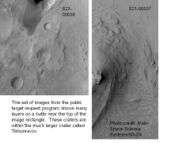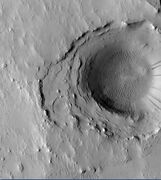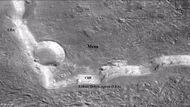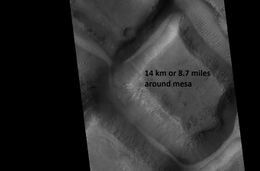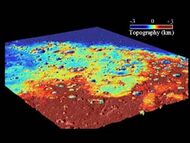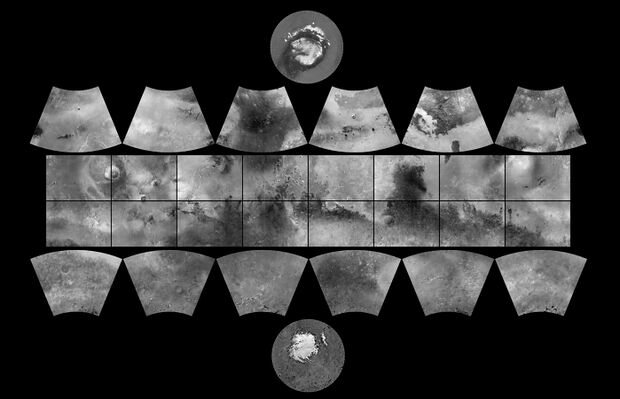Astronomy:Arabia Terra

Arabia Terra is a large upland region in the north of Mars that lies mostly in the Arabia quadrangle, but a small part is in the Mare Acidalium quadrangle. It is densely cratered and heavily eroded. This battered topography indicates great age, and Arabia Terra is presumed to be one of the oldest terrains on the planet. It covers as much as 4,500 km (2,800 mi) at its longest extent, centered roughly at [ ⚑ ] : 21°N 6°E / 21°N 6°E[1] with its eastern and southern regions rising 4 km (13,000 ft) above the north-west. Alongside its many craters, canyons wind through the Arabia Terra, many emptying into the large northern lowlands of the planet, which borders Arabia Terra to the north.
Features
Arabia contains many interesting features. There are some good examples of pedestal craters in the area. A pedestal crater has its ejecta above the surrounding terrain, often forming a steep cliff. The ejecta forms a resistant layer that protects the underlying material from erosion.[2] Mounds and buttes on the floor of some craters display many layers. The layers may have formed by volcanic processes, by wind, or by underwater deposition.[3][4] Dark slope streaks have been observed in Tikhonravov Basin, a large eroded crater. The streaks appear on steep slopes and change over time. At first they are dark, then turn a lighter color, probably by the deposition of fine, light colored dust from the atmosphere.[5] These streaks are thought to form by dust moving downslope in a way similar to snow avalanches on Earth.[6]
Arabia Terra was named in 1879 after a corresponding albedo feature on a map by Giovanni Schiaparelli, who named it in turn after the Arabian peninsula.
Possible tectonism
Research on the region was undertaken in 1997 and the individuality of the province better defined.[7] An equatorial belt was noted with a crater age distinctly younger than the northern part of the province and of Noachis Terra to the south. This was interpreted as an "incipient back-arc system" provoked by the subduction of Mars lowlands under Arabia Terra during Noachian times. Regional fracture patterns were also explained in this manner, and the rotational instability of the planet as a cause was not supported. It contains extension tectonic features[8]
Possible volcanism
A 2013 study proposed that a number of craters within Arabia Terra, including Eden Patera,[9] Euphrates Patera,[10] Siloe Patera,[11] and possibly Semeykin crater,[12] Ismenia Patera,[13] Oxus Patera[14] and Oxus Cavus,Cite error: Closing </ref> missing for <ref> tag
In popular culture
In the novel The Martian by Andy Weir, the protagonist encounters a dust storm in Arabia Terra while traveling from Acidalia Planitia to Schiaparelli crater.[15]
Layers
Many places on Mars show rocks arranged in layers. Rock can form layers in a variety of ways. Volcanoes, wind, or water can produce layers.[16] Layers may be formed by groundwater rising up depositing minerals and cementing sediments. The hardened layers are consequently more protected from erosion. This process may occur instead of layers forming under lakes.
A detailed discussion of layering with many Martian examples can be found in Sedimentary Geology of Mars.[17]
Layers in Tikonravev Crater in Arabia, as seen by Mars Global Surveyor (MGS). Layers may form from volcanoes, the wind, or by deposition under water. The craters on the left are pedestal craters. Some researchers believe this crater once held a massive lake.
Crater in the middle of Cassini, as seen by HiRISE. Layers may have been deposited under water since it is believed that Cassini once held a giant lake.
Buttes, as seen by HiRISE under HiWish program. Buttes have layered rocks with a hard resistant cap rock on the top which protects the underlying rocks from erosion.
Channels
Many places on Mars show channels of different sizes. Many of these channels probably carried water, at least for a time. One study that used HiRISE pictures found over 17,000 km of ancient river valleys in Arabia Terra.[18][19] Many ancient river valleys have been determined to be relatively recent, according to research published in 2016 in the Journal of Geophysical Research: Planets. These valleys carried water into lake basins. One lake, nicknamed "Heart Lake," had a volume similar to Lake Ontario.[20][21] The climate of Mars may have been such in the past that water ran on its surface. It has been known for some time that Mars undergoes many large changes in its tilt or obliquity because its two small moons lack the gravity to stabilize it, as the Moon stabilizes Earth; at times the tilt has even been greater than 80 degrees[22][23]
Channel in Arabia, as seen by HiRISE under HiWish program.
Close-up of channel within larger channel, as seen by HiRISE under HiWish program The existence of the smaller channel suggests water went through the region at least two times in the past. The black box represents the size of a football field. Some parts of the surface would be difficult to walk on with the many small hills and depressions.
Sklodowska (Martian crater), as seen by CTX camera (on Mars Reconnaissance Orbiter). Small channels are visible along the eroded, southern rim.
Upper Plains Unit
Parts of northern Arabia Terra contains the upper plains unit. The Upper Plains Unit is the remnants of a 50–100 meter thick mantling in the mid-latitudes. It was first investigated in the Deuteronilus Mensae (Ismenius Lacus quadrangle) region, but it occurs in other places as well. The remnants consist of sets of dipping layers in craters and along mesas.[24]
Some regions of the upper plains unit display large fractures and troughs with raised rims; such regions are called ribbed upper plains. Fractures are believed to have started with small cracks from stresses. Stress is suggested to initiate the fracture process since ribbed upper plains are common when debris aprons come together or near the edge of debris aprons—such sites would generate compressional stresses. Cracks exposed more surfaces, and consequently more ice in the material sublimates into the planet's thin atmosphere. Eventually, small cracks become large canyons or troughs.
This unit also degrades into brain terrain. Brain terrain is a region of maze-like ridges 3–5 meters high. Some ridges may consist of an ice core, so they may be sources of water for future colonists.
Linear ridge networks
Linear ridge networks are found in various places on Mars in and around craters.[25] Ridges often appear as mostly straight segments that intersect in a lattice-like manner. They are hundreds of meters long, tens of meters high, and several meters wide. It is thought that impacts created fractures in the surface, these fractures later acted as channels for fluids. Fluids cemented the structures. With the passage of time, surrounding material was eroded away, thereby leaving hard ridges behind. Since the ridges occur in locations with clay, these formations could serve as a marker for clay which requires water for its formation.[26][27][28] Water here could have supported past life in these locations. Clay may also preserve fossils or other traces of past life.
Pingos
Pingos are believed to be present on Mars. They are mounds that contain cracks. They contain pure water ice, so they would be a great source of water for future colonists on Mars
Wide view of ring-mold craters, as seen by HiRISE under HiWish program Location is the Ismenius Lacus quadrangle.
Mesas
Wide view of mesa with CTX showing cliff face and location of lobate debris apron (LDA). Location is Ismenius Lacus quadrangle.
Enlargement of previous CTX image of mesa This image shows the cliff face and detail in the LDA. Image taken with HiRISE under HiWish program. Location is Ismenius Lacus quadrangle.
Fractures forming blocks
In places large fractures break up surfaces. Sometimes straight edges are formed and large cubes are created by the fractures.
Glaciers
Wide view of flow moving down valley, as seen by HiRISE under HiWish program Location is Ismenius Lacus quadrangle.
Gallery
An oblique view of Arabia Terra produced by Mars Global Surveyor
Interactive Mars map
Error: Image is invalid or non-existent.
Map of quadrangles
For mapping purposes, the United States Geological Survey divides the surface of Mars into thirty "quadrangles", each named for a prominent physiographic feature within that quadrangle.[29][30] The quadrangles can be seen and explored via the interactive image map below.
See also
- Climate of Mars
- Geography of Mars
- Geology of Mars
- Impact crater
- List of craters on Mars
- List of quadrangles on Mars
References
- ↑ "Arabia Terra". Gazetteer of Planetary Nomenclature. USGS Astrogeology Research Program.
- ↑ "HiRISE | the Margin of a Pedestal Crater (PSP_008508_1870)". http://hirise.lpl.arizona.edu/PSP_008508_1870.
- ↑ "HiRISE - Layers in Central Mound of Henry Crater. (PSP_009008_1915)". http://hirise.lpl.arizona.edu/PSP_009008_1915.
- ↑ "HiRISE - Layers in Arabia Terra (PSP_004434_1885)". http://hirise.lpl.arizona.edu/PSP_004434_1885.
- ↑ "HiRISE - Slope Streaks in Tikhonravov Basin (PSP_007531_1935)". http://hirise.lpl.arizona.edu/PSP_007531_1935.
- ↑ "HiRISE - Layering and Slope Streaks in Henry Crater (PSP_006569_1915)". http://hirise.lpl.arizona.edu/PSP_006569_1915.
- ↑ Anguita, F. (1997). "Arabia Terra, Mars: Tectonic and Palaeoclimatic Evolution of a Remarkable Sector of Martian Lithosphere". Earth, Moon, and Planets 77 (1): 55–72. doi:10.1023/A:1006143106970. Bibcode: 1997EM&P...77...55A.
- ↑ Brugman, K., B. Hynek, S. Robbins. 2015. CRATER-BASED TESTS UNLOCK THE MYSTERY OF THE ORIGIN AND EVOLUTION OF ARABIA TERRA, MARS. Lunar and Planetary Science Conference 2359.pdf
- ↑ "Eden Patera". [USGS planetary nomenclature page]. USGS. http://planetarynames.wr.usgs.gov/Feature/15037.
- ↑ "Euphrates Patera". [USGS planetary nomenclature page]. USGS. http://planetarynames.wr.usgs.gov/Feature/15038.
- ↑ "Siloe Patera". [USGS planetary nomenclature page]. USGS. http://planetarynames.wr.usgs.gov/Feature/15042.
- ↑ "Semeykin". [USGS planetary nomenclature page]. USGS. http://planetarynames.wr.usgs.gov/Feature/5423.
- ↑ "Ismenia Patera". [ USGS planetary nomenclature page]. USGS. http://planetarynames.wr.usgs.gov/Feature/15039.
- ↑ "Oxus Patera". [USGS planetary nomenclature page]. USGS. http://planetarynames.wr.usgs.gov/Feature/15041.
- ↑ Weir, Andy (2014). The Martian. New York City: Crown Publishers. ISBN 978-0-8041-3902-1.
- ↑ "HiRISE | High Resolution Imaging Science Experiment". Hirise.lpl.arizona.edu?psp_008437_1750. http://hirise.lpl.arizona.edu?PSP_008437_1750.
- ↑ Grotzinger, J. and R. Milliken (eds.). 2012. Sedimentary Geology of Mars. SEPM.
- ↑ "Fossilized Rivers Suggest Mars Was Once Warm and Wet - SpaceRef". http://spaceref.com/mars/fossilized-rivers-suggest-mars-was-once-warm-and-wet.html.[yes|permanent dead link|dead link}}]
- ↑ Davis, J.; Balme, M.; Grindrod, P.; Williams, R.; Gupta, S. (2016). "Extensive Noachian Fluvial Systems in Arabia Terra: Implications for Early Martian Climate". Geology 44 (10): 847–850. doi:10.1130/G38247.1. Bibcode: 2016Geo....44..847D.
- ↑ "Some ancient Mars lakes formed long after others". https://www.sciencedaily.com/releases/2016/09/160915142043.htm.
- ↑ Wilson, Sharon A.; Howard, Alan D.; Moore, Jeffrey M.; Grant, John A. (2016). "A Cold-Wet Mid-Latitude Environment on Mars during the Hesperian-Amazonian Transition: Evidence from Northern Arabia Valleys and Paleolakes". Journal of Geophysical Research: Planets 121 (9): 1667–1694. doi:10.1002/2016JE005052. Bibcode: 2016JGRE..121.1667W.
- ↑ name; Touma, J.; Wisdom, J. (1993). "The Chaotic Obliquity of Mars". Science 259 (5099): 1294–1297. doi:10.1126/science.259.5099.1294. PMID 17732249. Bibcode: 1993Sci...259.1294T.
- ↑ Laskar, J.; Correia, A.; Gastineau, M.; Joutel, F.; Levrard, B.; Robutel, P. (2004). "Long term evolution and chaotic diffusion of the insolation quantities of Mars". Icarus 170 (2): 343–364. doi:10.1016/j.icarus.2004.04.005. Bibcode: 2004Icar..170..343L. https://hal.archives-ouvertes.fr/hal-00000860/file/Ma_2004.laskar_prep.pdf.
- ↑ Carr, M. 2001.
- ↑ Head, J., J. Mustard. 2006. Breccia dikes and crater-related faults in impact craters on Mars: Erosion and exposure on the floor of a crater 75 km in diameter at the dichotomy boundary, Meteorit. Planet Science: 41, 1675–1690.
- ↑ Mangold (2007). "Mineralogy of the Nili Fossae region with OMEGA/Mars Express data: 2. Aqueous alteration of the crust". J. Geophys. Res. 112 (E8): E08S04. doi:10.1029/2006JE002835. Bibcode: 2007JGRE..112.8S04M. https://hal.archives-ouvertes.fr/hal-00376813.
- ↑ Mustard (2007). "Mineralogy of the Nili Fossae region with OMEGA/Mars Express data: 1. Ancient impact melt in the Isidis Basin and implications for the transition from the Noachian to Hesperian". J. Geophys. Res. 112 (E8): E08S03. doi:10.1029/2006je002834. Bibcode: 2007JGRE..112.8S03M. https://hal.archives-ouvertes.fr/hal-00376823.
- ↑ Mustard (2009). "Composition, Morphology, and Stratigraphy of Noachian Crust around the Isidis Basin". J. Geophys. Res. 114 (7): E00D12. doi:10.1029/2009JE003349. Bibcode: 2009JGRE..114.0D12M. https://authors.library.caltech.edu/34913/1/2009JE003349.pdf.
- ↑ 29.0 29.1 Morton, Oliver (2002). Mapping Mars: Science, Imagination, and the Birth of a World. New York: Picador USA. p. 98. ISBN 0-312-24551-3.
- ↑ "Online Atlas of Mars". Ralphaeschliman.com. http://ralphaeschliman.com/id30.htm.
- ↑ "Online Atlas of Mars". http://ralphaeschliman.com/id30.htm. Retrieved December 16, 2012.
- ↑ "PIA03467: The MGS MOC Wide Angle Map of Mars". NASA / Jet Propulsion Laboratory. February 16, 2002. http://photojournal.jpl.nasa.gov/catalog/PIA03467. Retrieved December 16, 2012.
External links
- High resolution video by Seán Doran of overflight of a layered area in Arabia Terra
 |


